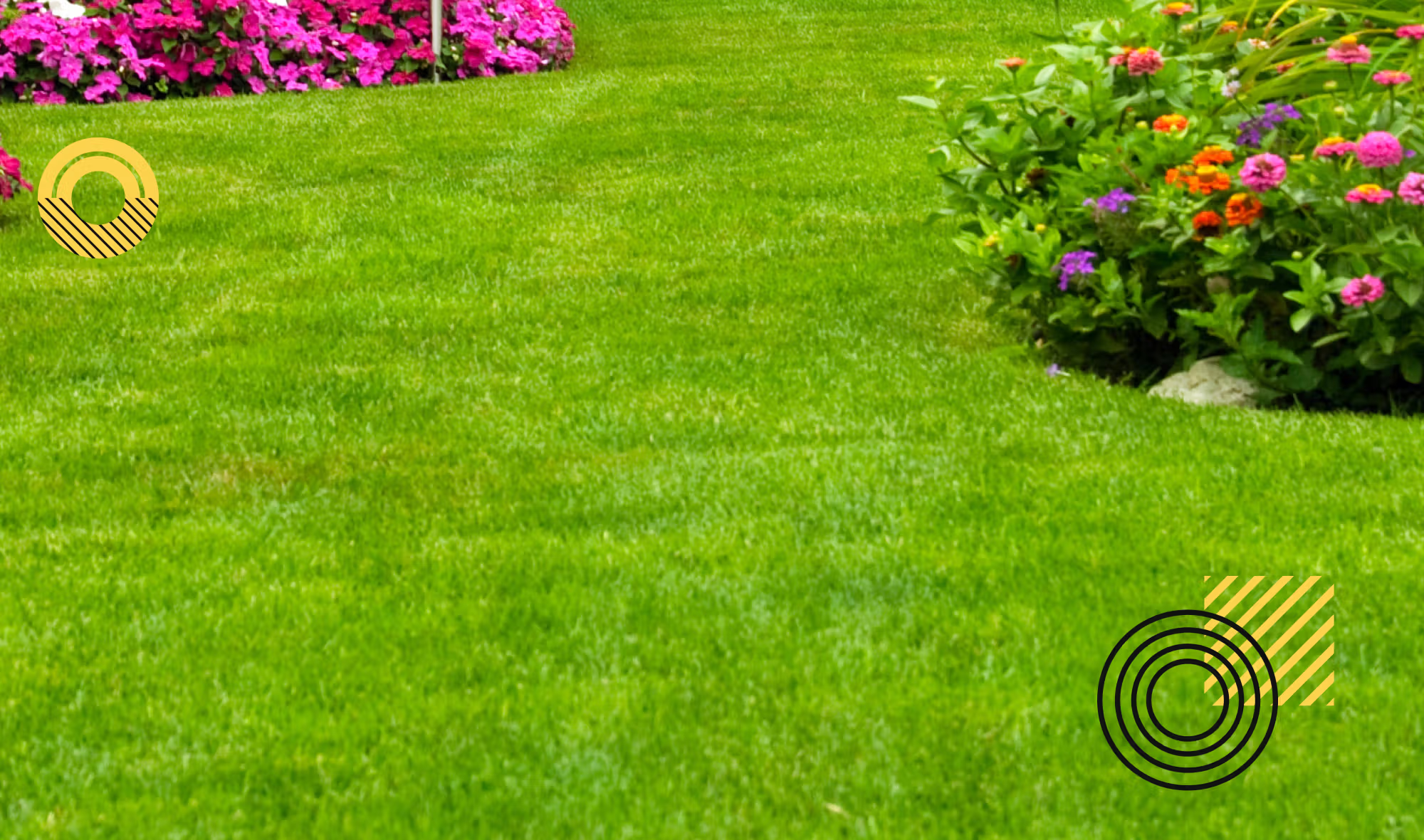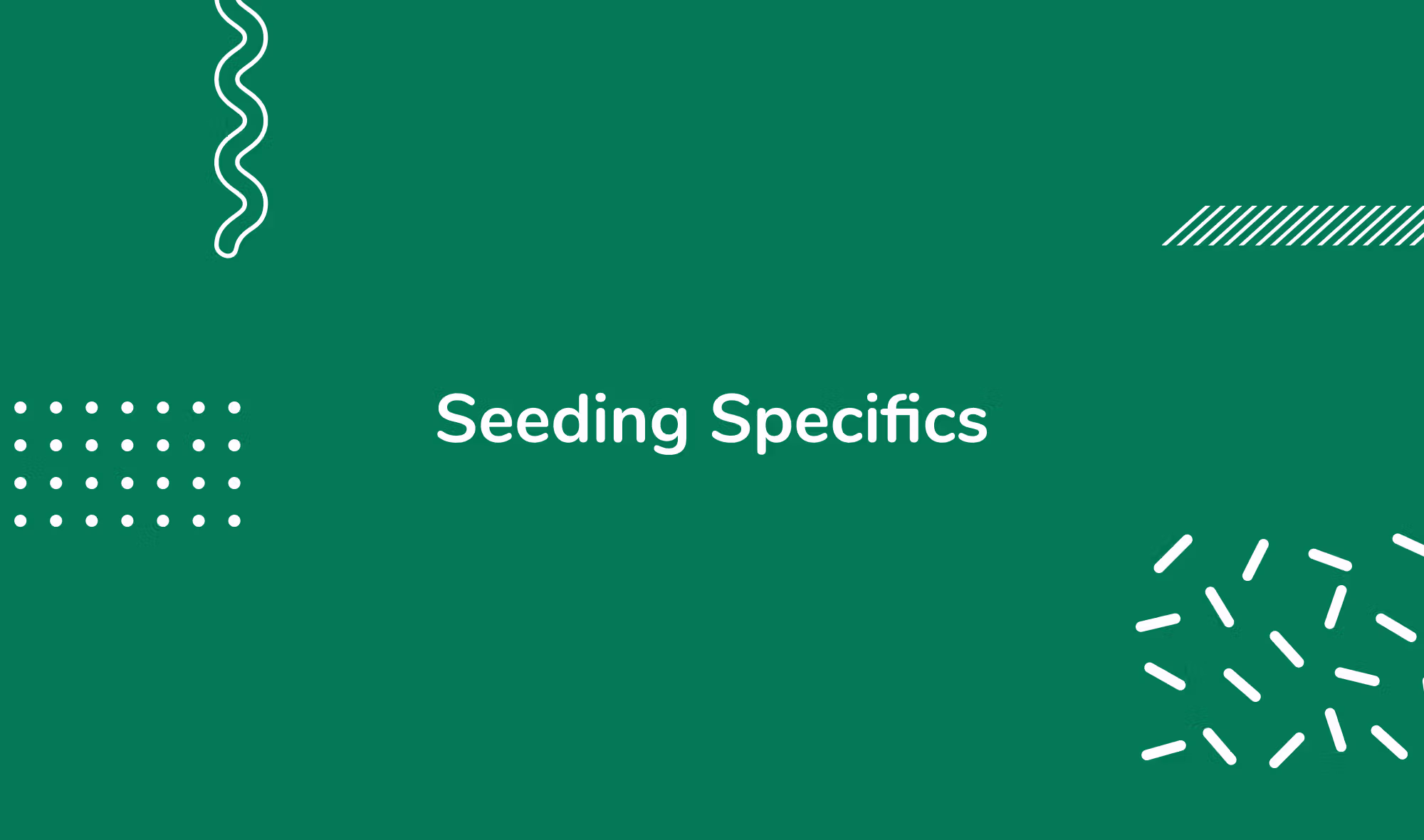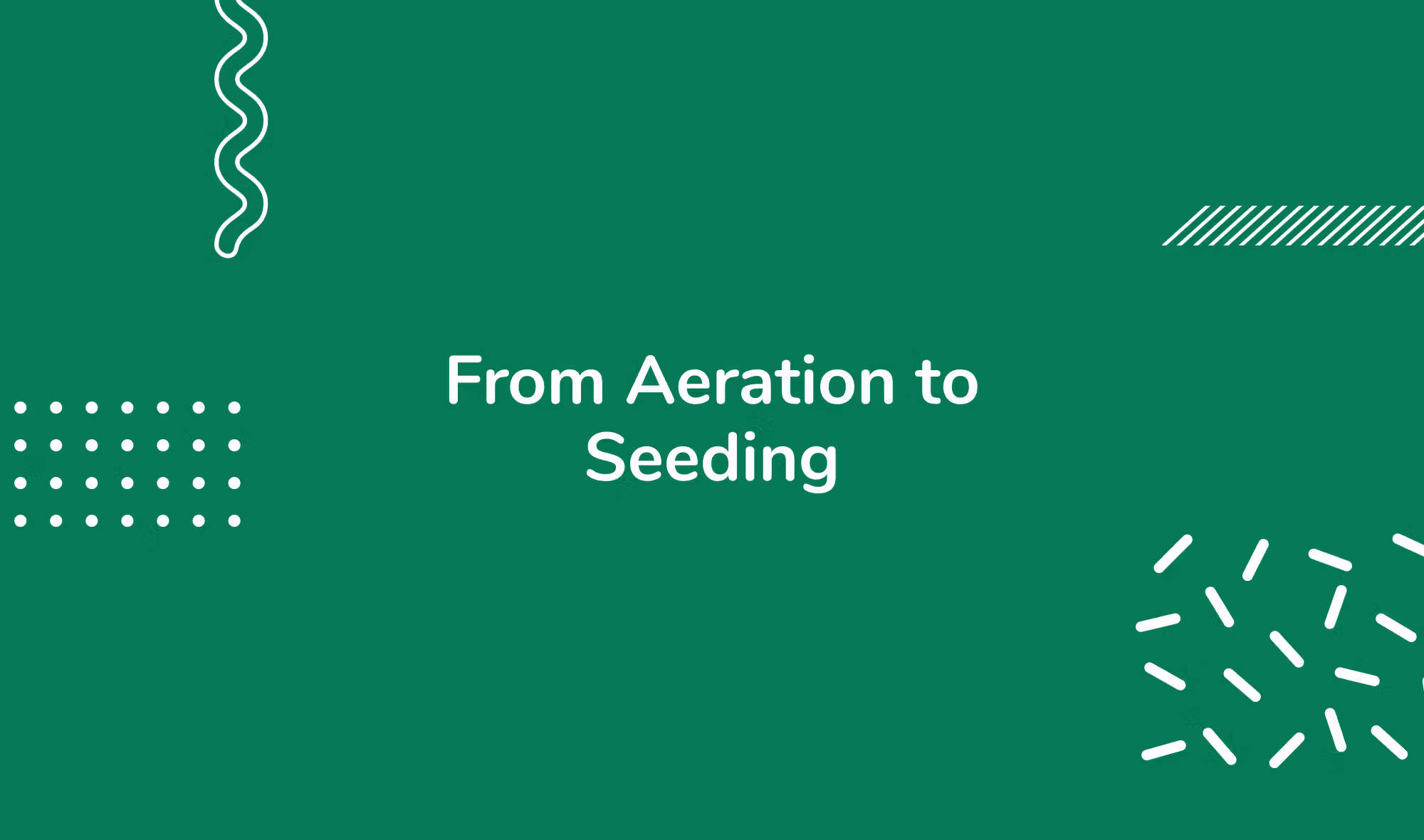Unlocking Your Lawn's Potential: The Art of Aeration and Overseeding
By HeyHome • June 11, 2023
Key Takeaways
- Aeration and overseeding are vital for a healthy, lush lawn.
- Timing is crucial for both aeration and overseeding, with cool season grasses best overseeded in early fall and warm season grasses in late spring.
- Post-aeration care, including watering and fertilizing, ensures the best results.
- Conducting aeration and overseeding properly involves a precise process and necessary tools.
- Aeration and overseeding are effective ways to address common lawn issues such as soil compaction, bare patches, and unhealthy grass.

A lush, verdant lawn is more than just a sight for sore eyes; it's a testament to the patience, hard work, and understanding of the art and science of lawn care that goes into its creation. Two critical factors to achieving this goal are aeration and overseeding. Done correctly, these practices can rejuvenate even the most tired-looking yards, creating a burst of healthy grass and new growth that can withstand both the harsh summer heat and heavy foot traffic.
Soil compaction is a common issue in many lawns, preventing grass roots from accessing the essential nutrients they need. The result? A less than perfect lawn. But fear not, this is where aeration steps in. By breaking up compacted soil, it breathes new life into your lawn, paving the way for a healthier root system. Think of aeration as giving your lawn a deep, rejuvenating massage.
Overseeding complements aeration by introducing new grass seed into the mix, fortifying your existing turf with fresh, resilient grass varieties. A well-executed overseeding can transform a sparse lawn into a thick, lush carpet of green, able to resist disease, weeds, and the harsh elements.
Aeration and overseeding are like two halves of a whole, each enhancing the effects of the other to revitalize your lawn. In this blog post, we'll delve deep into the art of aeration and overseeding, from understanding why and when to do it, to what happens after you’ve done the deed. By the end, you'll be armed with all the knowledge you need for your next big lawn renovation project.
So, whether you're a homeowner striving for the perfect lawn, or just someone curious about lawn care, stick around as we explore the hidden magic that lies within the world of aeration and overseeding. Because, after all, a healthy lawn doesn't happen by chance; it happens by understanding the needs of the grass, soil, and the delicate balance between them. Buckle up for a deep dive into the world of lawn care!
Join our newsletter
Stay on top of the latest in landscaping and lawn care with one valuable tip right in your inbox every Saturday morning.
The Science Behind Lawn Care: Understanding Aeration and Seeding
Lawns are often the backdrop of our everyday activities, yet the science that goes into maintaining them can easily be overlooked. Two critical elements of this process are aeration and seeding. Understanding these techniques can unlock the secret to a lush, healthy lawn. Let's dive in.
What is Aeration?
Aeration is the process of perforating the soil with small holes to allow air, water, and nutrients to penetrate the grass roots. Think of it like aerating a fine wine before sipping. This procedure helps to alleviate soil compaction, a common issue in many lawns. Compacted soil restricts the space around grass roots, making it hard for your lawn to breathe and access essential nutrients.
Core aeration, one of the most common forms of aeration, involves the use of a core aerator. This piece of aerator equipment is designed to remove small plugs or "cores" of soil and thatch from the lawn. These aeration holes left by the removal of soil plugs allow air, water, and nutrients to reach grass roots more effectively. They also provide room for new grass seed to find its home in the soil, encouraging new growth and a healthier lawn.
What is Seeding?
Seeding, in the context of lawn care, refers to the process of adding new grass seed to your existing lawn. This is usually done to improve the density of your grass or to introduce a more resilient grass variety into your existing turf.
When overseeding, grass seeds are spread across the lawn, typically with a lawn spreader, to fill in thin spots or bare patches. The new grass seed germinates and grows, intertwining with the existing grass, creating a thicker, more robust lawn.
Seeding, particularly overseeding, introduces a new lease of life into your lawn. It helps fill bare spots, improves the color and density of your lawn, and enhances your lawn's ability to fight pests and diseases.
The Importance and Benefits of Aeration and Seeding
Together, aeration and overseeding can work wonders on your lawn.
Aerating your lawn is like opening the doors to your home for some fresh air. It reduces soil compaction, allowing water, oxygen, and nutrients to reach grass roots more efficiently. It helps to create a healthier root system and promotes vigorous growth.
Overseeding introduces new grass varieties into your lawn, giving it a denser, greener look. It also fortifies your lawn against diseases and pests. When combined with aeration, the seeds have an easier time finding their way into the soil, allowing for better seed-to-soil contact and, ultimately, healthier and thicker growth.
In essence, aeration and seeding are essential tools in your lawn care toolkit, especially if you're aiming for a lush lawn that's not just beautiful to look at, but also healthy and resilient.
To learn more about achieving the greenest grass, check out this comprehensive guide to lawn care from HeyHome. To learn more about a overseeding in spring, check out our guide here.
Unlocking Your Lawn's Potential: The Art of Aeration and Overseeding

Just like a master painter knows the perfect color combinations to create a stunning painting, a seasoned gardener knows that the combination of aeration and overseeding can unlock the full potential of a lawn. This synergy of practices can create a stunning landscape right outside your doorstep.
The Synergy of Aeration and Overseeding
Aeration and overseeding are two practices that, when used together, greatly complement one another. They're a one-two punch in the world of lawn care that can tackle common lawn problems such as compacted soil and bare patches.
First, aeration is performed using a machine such as a core aerator, which removes small plugs of soil from your lawn. This process alleviates soil compaction, allowing for better circulation of air, water, and essential nutrients. Aeration holes from the removed soil plugs create the perfect tiny homes for new grass seed to nestle into. These holes provide the new seed with direct contact with the soil, boosting the chances of successful germination.
Following aeration, overseeding is performed. This is where new grass seed is spread evenly across your lawn, including the aeration holes. The new grass seed settles into these holes, which not only provides the seed with a shield from birds and other elements but also places them directly into the soil. This leads to more effective germination, better root growth, and ultimately, a thicker, healthier lawn.
Impact on Your Lawn's Health and Appearance
The combination of aeration and overseeding has a significant impact on your lawn's health and overall appearance.
On the health side, aeration helps alleviate soil compaction, one of the biggest enemies of a healthy lawn. It enables water, air, and nutrients to reach grass roots more effectively, promoting deeper roots and a healthier root system. Meanwhile, overseeding introduces new grass into your lawn, which helps improve your lawn's resistance to diseases and pests. This can be particularly helpful if your lawn consists mostly of older grass varieties that may be susceptible to common lawn diseases or pests.
On the appearance side, overseeding following aeration can give your lawn a thicker, lusher look. As the new grass seed germinates and grows, it fills in thin or bare spots, resulting in a denser, more robust lawn. If you've chosen a grass variety that's known for its color or texture, overseeding can also enhance the aesthetic appeal of your lawn.
In essence, combining aeration with overseeding helps create a lawn that is not just healthier but also more attractive. These practices are key to unlocking your lawn's potential and can turn any lawn into a lush, green oasis.
To delve deeper into the comprehensive care of your lawn, make sure to check out our guide on achieving the greenest grass.
Timing is Key: Determining the Best Time to Aerate and Overseed Lawn

Just like every aspect of nature, lawn care also has its rhythm and timing. When it comes to aeration and overseeding, choosing the right time can significantly impact the success of these practices. Let's delve into the factors you should consider when deciding when to aerate and overseed.
Factors Affecting the Best Time to Aerate and Overseed
The best time to aerate and overseed your lawn depends on several factors, including the type of grass in your lawn, your local climate, and the current state of your lawn.
Firstly, you need to identify whether your lawn has cool season grasses or warm season grasses. Cool season grasses, such as Kentucky bluegrass or tall fescue, typically have two growing seasons: early spring and early fall. Warm season grasses, such as Bermuda grass or zoysia grass, tend to grow during late spring and throughout the hot summer months.
This differentiation is crucial because the best time to aerate and overseed is generally at the start of these growing seasons, when the grass is actively growing and can recover quickly from the aeration process.
Additionally, your local climate also plays a significant role. The ideal time for aeration and overseeding is when the soil temperatures are optimal for grass seed germination and when there's enough moisture in the soil, but not too much that it could lead to soil compaction.
Lastly, the current state of your lawn can dictate the best timing. For instance, if your lawn is suffering from excessive thatch or if it has become particularly compacted due to heavy foot traffic, it may be beneficial to aerate and overseed sooner rather than later.
Join our newsletter
Stay ahead of the curve in all things outdoor.
Get the inside scoop on the latest landscaping, lawn care, and fencing trends with 1 actionable tip every Saturday morning.
Seasonal Considerations
As mentioned earlier, seasonal timing is crucial when it comes to aeration and overseeding. For cool season grasses, the best time to aerate and overseed is usually early fall or early spring. During these periods, the soil is often moist and cool, providing a favorable environment for grass seeds to germinate and roots to grow deeper.
On the other hand, warm season grasses benefit from aeration and overseeding in late spring or early summer when the weather starts to warm up.
Remember, overseeding immediately after aeration takes advantage of the aeration holes, providing new grass seeds with an ideal location to grow.
Understanding Your Lawn's Needs and Unique Characteristics
Every lawn is unique. Therefore, understanding your lawn's specific needs and characteristics is key to determining the best time to aerate and overseed. Factors such as the type of soil, the level of foot traffic your lawn receives, and the specific grass species can all affect timing.
The state of your existing lawn is another important factor. If you notice areas of thin or bare patches, or if your grass appears to be growing slowly or is losing its vibrant color, it might be time for aeration and overseeding.
In summary, timing is indeed key when it comes to aeration and overseeding. By understanding your lawn's unique needs and considering factors such as grass type and local climate, you can make an informed decision on the best time to undertake these essential lawn care practices. Armed with this knowledge, you'll be well on your way to achieving a lush, vibrant, and healthy lawn.
Seeding Specifics: Pinpointing the Best Time to Overseed Lawn

While understanding the interplay of aeration and overseeding is important, knowing when to specifically overseed is equally vital. Correct timing can dramatically improve the success rate of the new grass seed, helping you achieve that thick, lush lawn you dream of.
Importance of Timing When Overseeding
Timing is everything, especially when it comes to overseeding your lawn. When done correctly, overseeding can help you improve the density of your lawn, fill in bare spots, and introduce a more resilient type of grass into your existing lawn. But these benefits are only maximized when overseeding is done at the right time.
The best time to overseed a lawn is generally during the active growing season of the specific type of grass in your lawn. This is when the existing grass is strong and growing quickly, which provides the best environment for new grass seed to germinate and grow.
Impact of Weather Conditions and Seasons
Weather conditions, particularly temperature and moisture, have a significant impact on grass seed germination and growth.
For cool season grasses, the best time to overseed is typically in early fall or early spring. In the fall, the soil is still warm from the summer heat, which encourages grass seed germination, and the cooler air temperatures are less stressful for the new grass growth. Similarly, in early spring, the soil begins to warm up, and cool season grasses start their active growth, providing another excellent window for overseeding.
For warm season grasses, late spring or early summer are generally the best times to overseed. At this time, soil temperatures are increasing, and these grasses enter their prime growing season.
Regardless of the type of grass, it's crucial to ensure that there's sufficient moisture when overseeding. This might come from rainfall, or you may need to water the lawn yourself. The key is to keep the new grass seed moist to facilitate germination, but avoid overwatering, which could lead to other issues such as disease.
Weather conditions and seasons indeed play a huge role when it comes to overseeding. By understanding the nature of your grass and tuning into the rhythm of the seasons, you can time overseeding to maximize its impact, ultimately promoting a vibrant and lush lawn.
The Aftermath: What to Do After Aerating Your Lawn

Lawn care doesn't end with the process of aeration; in fact, the true nurturing begins afterwards. Once your lawn has been aerated, proper aftercare can enhance the benefits of this practice and set your lawn up for success.
Care Tips Post Aeration
After aeration, the most important tip is to keep off the lawn as much as possible to allow it to recover. Foot traffic should be minimized to avoid compacting the loose soil in the aeration holes.
Another key consideration is leaving the soil plugs on the lawn. These plugs will naturally break down and disappear within a few weeks. As they break down, they help to redistribute nutrients back into the lawn's soil. This contributes to a healthier lawn by improving the soil structure and reducing thatch.For effective overseeding, consider using a high-quality fertilizer spreader.
Importance of Watering and Fertilizing
Watering and fertilizing your lawn post aeration are crucial steps to support healthy grass growth.
Firstly, watering helps the soil settle back into the aeration holes and promotes the germination of new grass seed if you've overseeded. After aerating, ensure the lawn is watered thoroughly. The goal is to maintain moist soil without causing any run-off.
Secondly, fertilizing after aeration provides your lawn with the proper nutrients it needs to recover and grow. Since aeration promotes better soil access, fertilizing post aeration ensures that these nutrients can reach the grass roots more effectively.
Potential Challenges and How to Address Them
Just like any lawn care practice, aeration might bring some challenges. One common challenge is dealing with an excessively thatchy lawn. If this is the case, consider dethatching your lawn before aeration. This will remove the excess layer of dead grass and leaves, allowing the aerator to reach the soil more effectively.
Another potential challenge is the need to water more frequently, especially in the days following aeration. A newly aerated lawn may dry out faster due to increased exposure to sun and air. Keep a close eye on your lawn to ensure it's getting the moisture it needs without becoming waterlogged.
In conclusion, understanding what to do after aerating your lawn is just as crucial as the aeration process itself. With proper aftercare, including minimizing foot traffic, watering and fertilizing appropriately, and managing potential challenges, you can ensure that your lawn maximizes the benefits of aeration, leading to a more vibrant, lush, and healthy landscape.
From Aeration to Seeding: The Entire Lawn Care Process

Understanding the why and when of aeration and overseeding is only half the battle. Now, let's delve into the how, providing you with a step-by-step guide on these processes, the tools you'll need, and common mistakes you should steer clear from.
A Step-by-Step Guide on How to Aerate and Seed Your Lawn
Step 1: Prep Your Lawn
Begin by mowing your lawn slightly lower than your regular mowing height. This allows the aerator equipment to reach the soil more effectively. Additionally, water your lawn thoroughly a day before aeration to soften the soil and make it easier to extract plugs.
Step 2: Aerate Your Lawn
Using a core aerator, go over your lawn just as you would when mowing. For areas with compacted soil or heavy foot traffic, consider making multiple passes to ensure proper aeration. Remember to leave the extracted soil plugs on the lawn; they will break down and contribute to the overall health of your lawn.
Step 3: Overseed Your Lawn
Immediately after aeration, spread the new grass seed over your lawn using a lawn spreader. Ensure you distribute the seed evenly over the entire lawn, paying particular attention to bare patches.
Step 4: Water and Fertilize
Water the lawn thoroughly after overseeding to help the seeds settle into the aeration holes. In the following weeks, keep the soil moist, but avoid overwatering. Additionally, apply a slow-release fertilizer to provide the necessary nutrients for both the existing and new grass growth.
Step 5: Regular Maintenance
Continue with regular lawn care practices, such as mowing and watering. However, avoid heavy foot traffic on your lawn for at least a couple of weeks to give the new grass seed a chance to germinate and grow.
Necessary Tools and Equipment
To successfully aerate and overseed your lawn, you'll need the following tools: a lawn aerator (core aerator recommended), a lawn spreader for overseeding, a garden hose or sprinkler system for watering, and a slow-release fertilizer.
Common Mistakes to Avoid
One of the most common mistakes in lawn aeration and overseeding is improper timing. Make sure to aerate and overseed during the active growth season of your specific type of grass.
Another common mistake is not watering or fertilizing the lawn after overseeding. These steps are critical for the germination and growth of the new grass seed.
Lastly, avoid overdoing it. While it's important to ensure your lawn is adequately aerated and overseeded, too much can be detrimental. Over-aerating can stress your lawn, and overseeding too heavily can cause competition among grass seeds, hindering their growth.
With this comprehensive guide, you now have a roadmap to the successful aeration and overseeding of your lawn. By understanding the step-by-step process, equipping yourself with the right tools, and avoiding common mistakes, you're well on your way to enhancing your lawn's health and beauty.
Conclusion
Navigating through the myriad of lawn care practices, you've made it to the end of our comprehensive guide on aeration and overseeding. These processes, while seemingly simple, can significantly influence the health, appearance, and longevity of your lawn when done properly.
Aeration and overseeding are more than just routine lawn care practices. They're essential tools in your arsenal to unlock your lawn's potential and maintain its vibrancy throughout the year. A well-aerated and overseeded lawn can stand up to the challenges of weather, foot traffic, and time, maintaining its lushness and appeal.
FAQs
After going through our in-depth discussion about aeration and overseeding, you might still have a few questions or concerns. This section addresses some common questions and misconceptions about these practices and lawn care in general.
Can I aerate and overseed at the same time?
Yes, you can — and it's even recommended to do so. Overseeding immediately after aeration allows the new grass seed to make the most of the aeration holes, providing them with direct contact with the soil and a protected area to germinate.
How often should I aerate and overseed my lawn?
The frequency of aeration and overseeding depends on your lawn's health and your specific type of grass. Generally, most lawns benefit from aeration and overseeding once a year. Lawns with heavy clay soil or those subject to high foot traffic might require more frequent aeration.
Is it possible to overseed without aerating?
While it's possible to overseed without aerating, aerating before overseeding offers substantial benefits. Aeration reduces soil compaction and allows the seeds to come into direct contact with the soil, enhancing their chances of germination and growth.
Can I mow my lawn after overseeding?
After overseeding, wait until the new grass is at least one-third taller than your regular mowing height before mowing. This allows the new grass sufficient time to establish strong roots, ensuring its survival and growth.
Should I water my lawn immediately after aeration?
Yes, it's beneficial to water your lawn immediately after aeration. The water will seep into the aeration holes, moistening the soil and encouraging the grass roots to grow deeper, which promotes a healthier lawn.
Is aeration necessary if I have new turf?
Even new lawns can benefit from aeration, especially if the soil is compacted. Aeration can help encourage deep root growth, which is crucial for the long-term health and resilience of your lawn.
Understanding the answers to these frequently asked questions can provide you with an even better grasp of aeration, overseeding, and their roles in lawn care. With this knowledge in your toolkit, you're well-equipped to take your lawn's health and beauty to the next level.
Join our newsletter
Stay ahead of the curve in all things outdoor.
Get the inside scoop on the latest landscaping, lawn care, and fencing trends with 1 actionable tip every Saturday morning.